The humble corn snake (Pantherophis guttatus) has captivated reptile enthusiasts for decades with its docile temperament, manageable size, and incredible genetic diversity. While many people are familiar with classic morphs like Amelanistic, Snow, and Okeetee, the world of corn snake genetics has expanded dramatically in recent years. Dedicated breeders have unlocked combinations that would have seemed impossible just a decade ago, creating snakes with colors and patterns that defy imagination. This article explores some of the most fascinating yet lesser-known corn snake morphs that deserve more recognition in the reptile community. From subtle variations with complex genetic backgrounds to bold statement morphs that stop viewers in their tracks, these uncommon varieties showcase the remarkable genetic plasticity of this beloved species.
Tessera: The Pattern Transformer

The Tessera morph represents one of the most significant pattern mutations to emerge in corn snake breeding this century. First appearing in 2006 in the collection of South Mountain Reptiles, Tessera corn snakes display a dramatic disruption of the traditional saddle pattern. Instead of distinct, separated saddles, Tessera snakes feature interconnected markings that create a net-like or maze pattern along their dorsal surface. The belly typically shows an unusual checkerboard pattern rather than the normal “checkers” arrangement. What makes Tessera particularly exciting for breeders is that it’s a dominant mutation, meaning it only requires one copy of the gene to express visually, allowing for rapid incorporation into other genetic lines. When combined with color mutations like Lavender or Caramel, Tessera creates some truly outstanding specimens with both unique coloration and revolutionary patterning.
Tessera-Corn-Snake: The Sparkling White Canvas
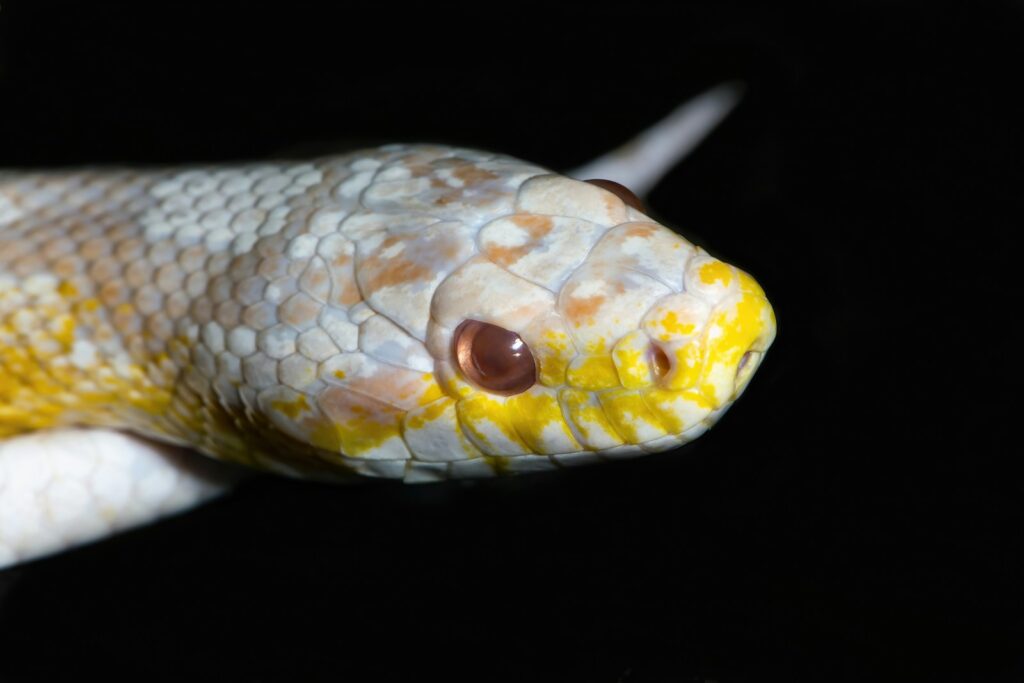
Palmetto corn snakes emerged relatively recently and immediately captured attention with their striking appearance. These snakes display a predominantly white body with scattered specks or patches of color that resemble freckles or splatter paint. The genetic components of Palmetto are particularly interesting, requiring both the Ultramel gene (a variant of Amelanism) and a separate “whitewashing” gene that scientists still don’t fully understand. Breeding Palmettos can be challenging because producing the perfect balance of white background and colored speckling requires careful genetic selection. The most prized specimens show a crisp white base with just enough colored spots to create visual interest without overwhelming the clean canvas effect. As these snakes mature, their pattern often shifts subtly, with some specimens developing more extensive speckling while others maintain their predominantly white appearance throughout adulthood.
Scaleless: The Silky Sensation
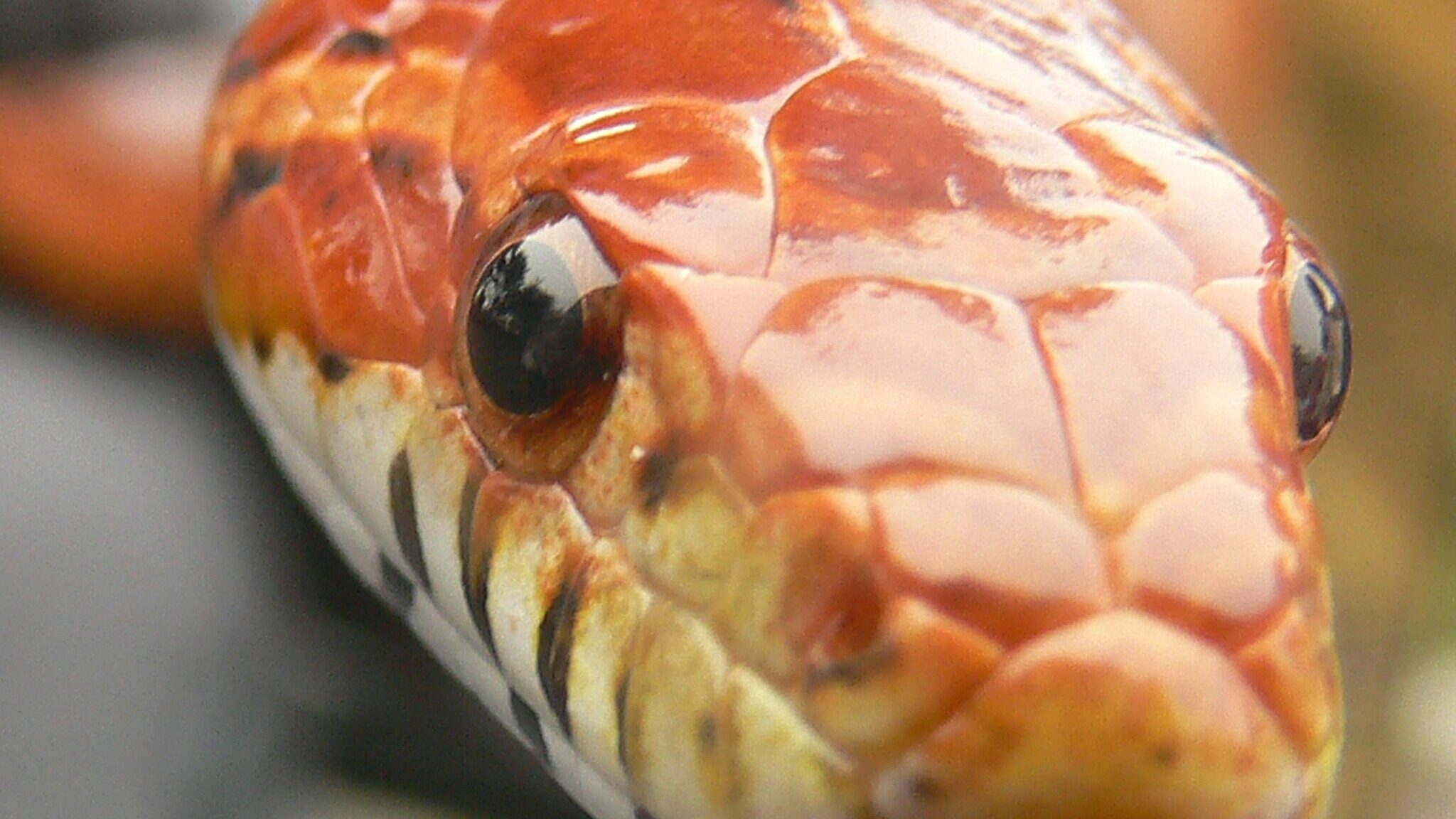
While not strictly a color morph, the Scaleless mutation represents one of the most dramatic departures from the typical corn snake phenotype. These snakes lack traditional scales over most of their body, resulting in smooth, silky skin that feels remarkably different to the touch. They typically retain small scales on their belly (ventral scales) which are necessary for proper locomotion, and often have a small cap of scales on their head. The Scaleless trait can be combined with virtually any color morph, creating endless possibilities like Scaleless Tesseras, Scaleless Caramels, or even more complex combinations. Their unusual texture makes them particularly sought after by collectors who appreciate both visual and tactile uniqueness. However, these snakes require special care considerations, including higher humidity environments and protection from abrasions that might damage their more vulnerable skin.
Sunspot: The Golden Constellation
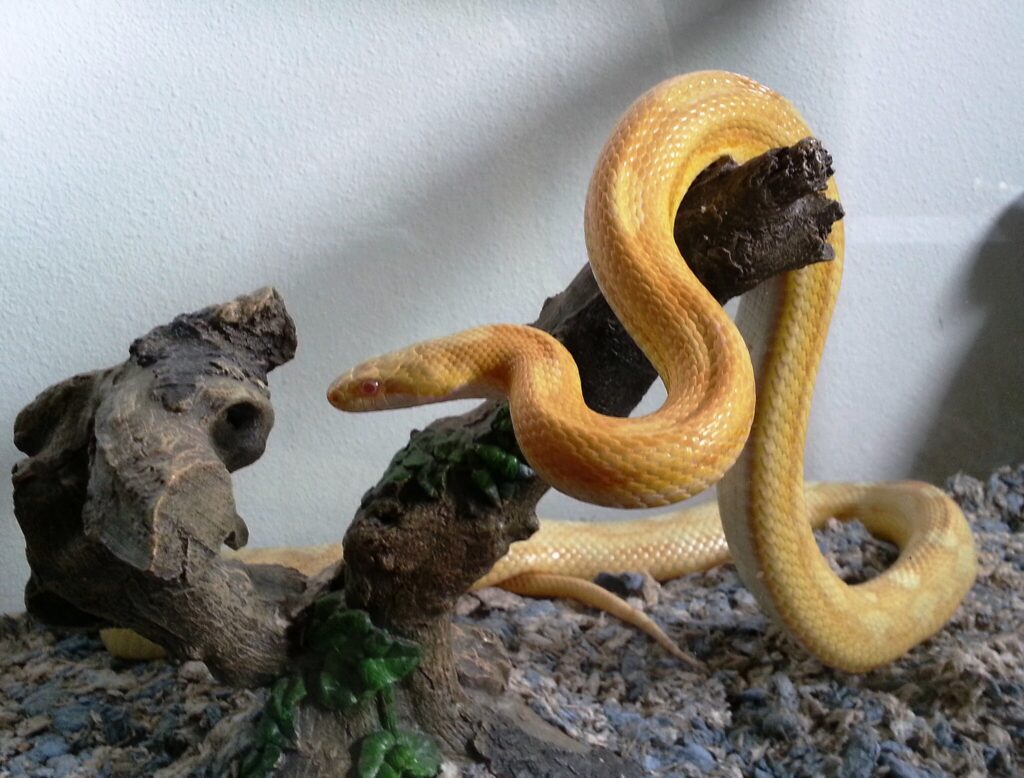
The Sunspot morph combines several genetic components to create a snake with a rich yellow to orange background adorned with random spots reminiscent of a starry sky. This complex morph typically involves both Caramel and Diffused genes, along with other genetic factors that enhance the yellowing of the background coloration. What makes Sunspots particularly interesting is how their pattern evolves as they mature, with young specimens often showing more conventional patterning that gradually breaks into the characteristic spots through their first year of growth. The random nature of the spotting means that no two Sunspot corn snakes are exactly alike, giving each specimen a unique appearance. These snakes have become increasingly popular among experienced keepers looking for something that stands out dramatically from conventional corn snake patterns while still maintaining the classic warm coloration that made corn snakes popular in the first place.
Lava: The Glowing Ember
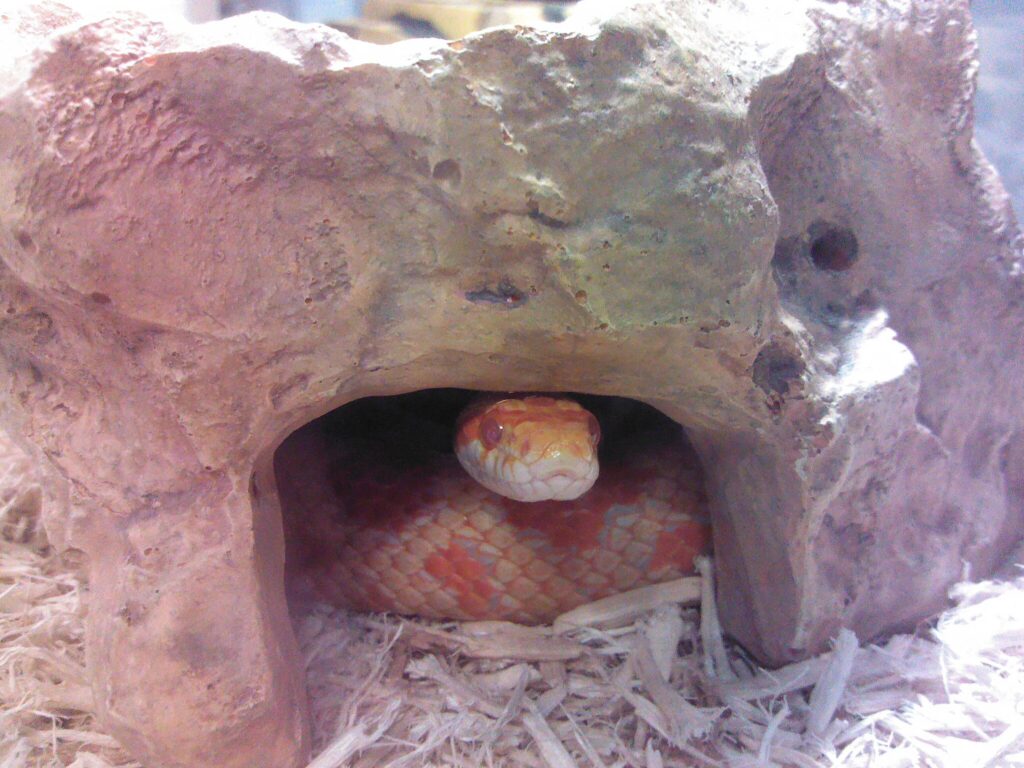
Lava corn snakes represent one of the most visually striking morphs developed in recent years, characterized by a rich, deep orange-red base color with dramatically darkened borders around each scale. This creates an effect reminiscent of cooling lava with glowing cracks between darker surfaces. The Lava morph results from combining several genetic factors, including Diffused, Striped, and Hypomelanistic traits, though the exact genetic mechanics continue to be studied by dedicated breeders. These snakes typically display minimal pattern disruption on their sides but maintain a strong contrast between their vibrant ground color and the darkened scale edges. The visual impact of Lava corn snakes tends to increase with age, as their colors often intensify after each shed cycle during their first two years. When viewed under UVA lighting, the contrast becomes even more pronounced, creating an almost luminous appearance that gives these snakes their perfectly descriptive name.
Orchid: The Pastel Dream
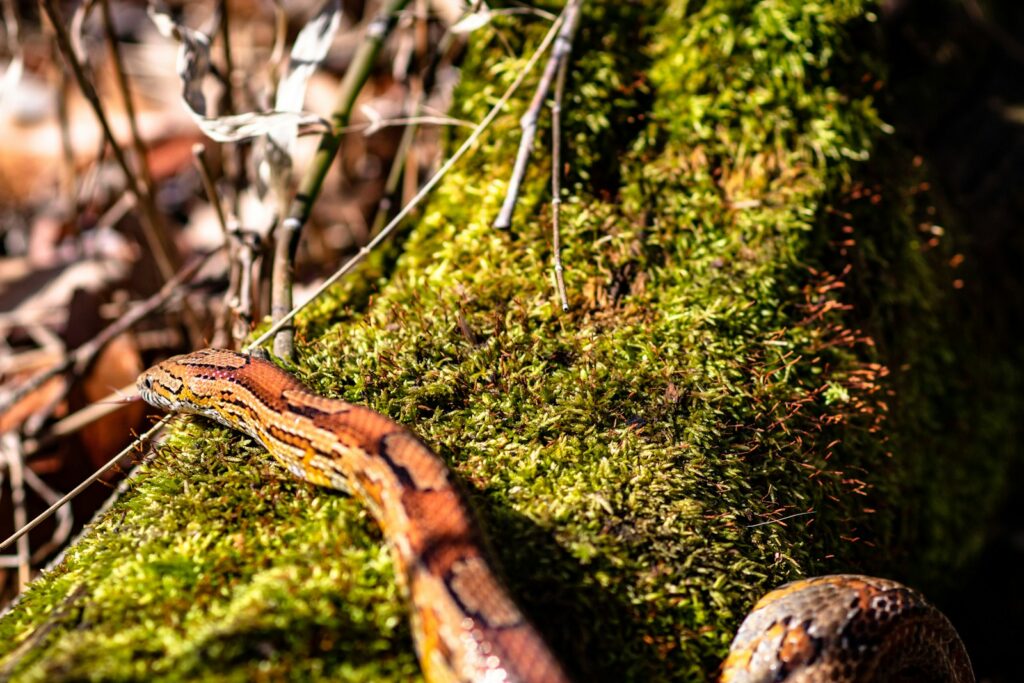
Orchid corn snakes emerged as a surprise discovery when breeders noticed unusual lavender-pink hatchlings appearing in certain genetic lines. This recessive mutation produces snakes with soft pastel lavender to pink body coloration and distinctive ruby-red eyes. What separates Orchids from other lavender-spectrum morphs is the unique purplish-pink hue that remains consistent throughout the snake’s life, rather than fading or darkening with age as many morphs do. The pattern on Orchid corn snakes typically remains normal, with standard saddle markings, allowing the unusual coloration to take center stage. Particularly attractive specimens display a gradient effect where the coloration deepens along the spine and lightens toward the sides. When combined with pattern mutations like Stripe or Motley, Orchid corn snakes develop an ethereal quality that makes them appear almost artificial in their perfect coloration.
Banana: The Tropical Twist
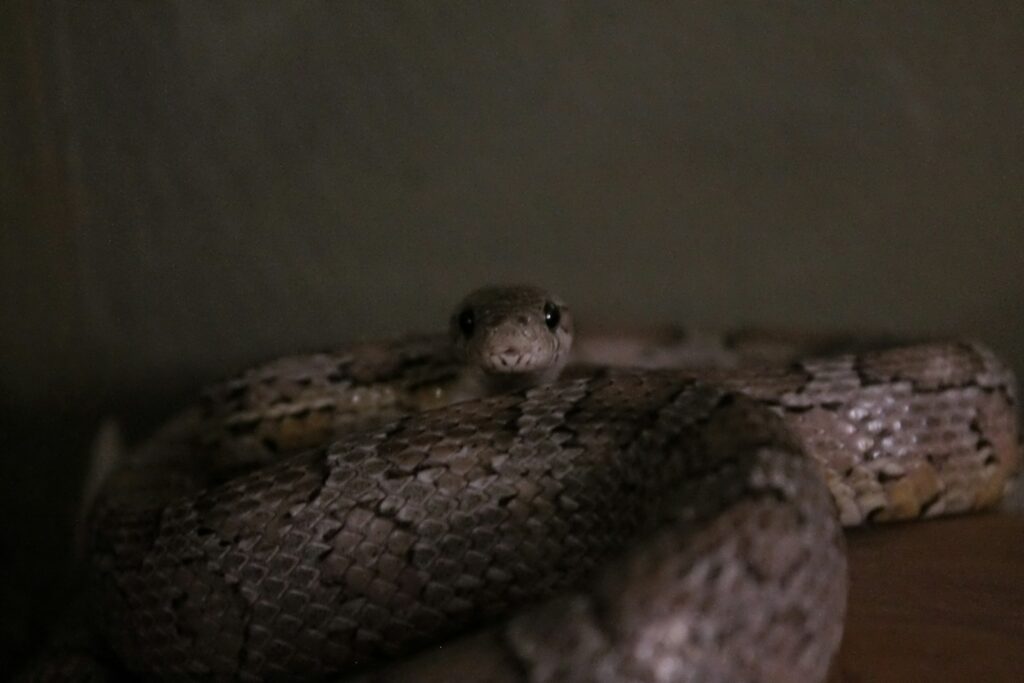
Not to be confused with the popular Ball Python morph of the same name, Banana corn snakes display a unique yellow to peach ground color with reduced or heavily modified patterning. This morph represents a complex genetic combination involving Caramel, Hypomelanistic, and potentially other genetic factors that work together to suppress dark pigments while enhancing yellow chromatophores. Young Banana corn snakes often hatch with a more typical pattern that gradually fades as the snake matures, eventually resulting in an almost patternless appearance in some specimens. The most prized examples display a bright, consistent yellow-orange coloration reminiscent of a perfectly ripe banana, with just enough pattern remaining to create visual interest. Banana corns have surged in popularity among keepers who appreciate brightly colored snakes but prefer the more manageable size and temperament of corn snakes compared to larger python species.
Russo Line Diffused: The Unblemished Elegance
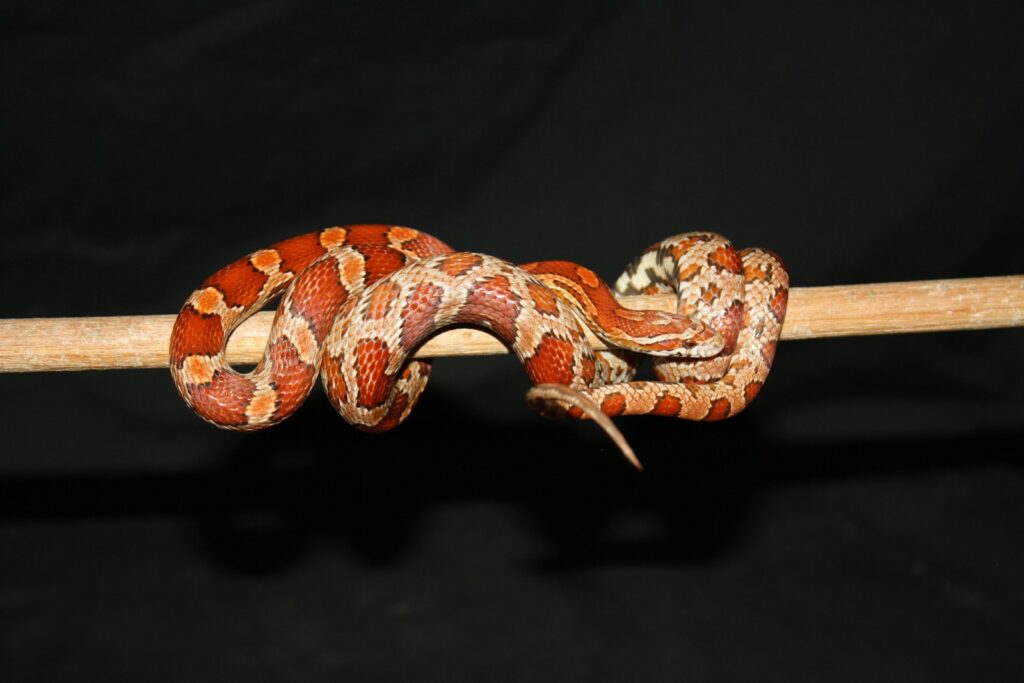
While the Diffused gene is relatively well-known in corn snakes, the specific Russo line of Diffused specimens stands out for its exceptional quality and consistency. These snakes, first developed by renowned breeder Peter Russo, completely lack the traditional belly checkerboard pattern, resulting in a clean, unmarked ventral surface. What makes Russo Line Diffused snakes special is their predictable ability to create “buckle-free” specimens when bred properly, avoiding the pinched appearance that can occur in other Diffused bloodlines. The dorsal pattern in these snakes is also significantly altered, with saddles that extend further down the sides and often blur together to create a more uniform appearance. When combined with other mutations like Amelanism, Russo Line Diffused snakes produce some of the most striking Bloodred and Candy Cane corn snakes available, with vibrant, uninterrupted coloration that makes them particularly photogenic.
Pied-Sided: The Split Personality
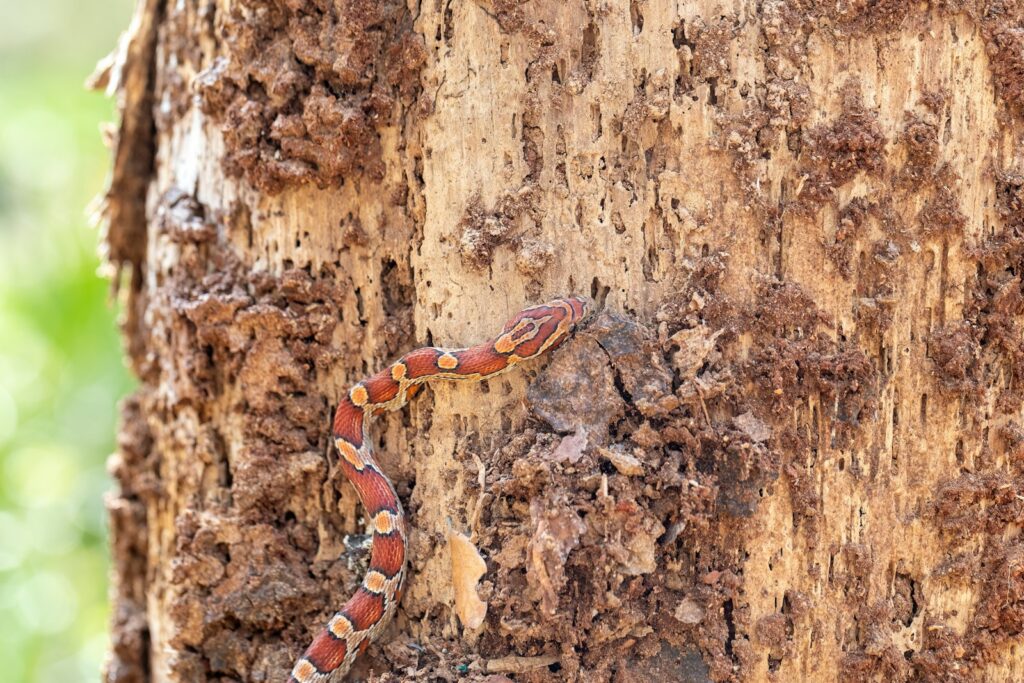
Pied-Sided corn snakes feature a remarkable appearance where part of their body displays normal patterning while other sections are completely patternless. Unlike true Piebald mutations seen in other snake species, the Pied-Sided trait in corn snakes typically affects the sides of the body, creating a distinct line where pattern abruptly stops. This fascinating morph results from a recessive mutation that was discovered independently by several breeders in the early 2000s. The most dramatic examples show a perfect delineation between patterned and patternless areas, creating an almost two-toned appearance when viewed from above. Pied-Sided can be combined with virtually any color morph, allowing for endless creative possibilities like Pied-Sided Lavenders or Pied-Sided Amels. Interestingly, the extent of the patternless areas can vary widely even among siblings from the same clutch, making each specimen truly unique.
Genetic Stripe: The Perfect Pinstripe
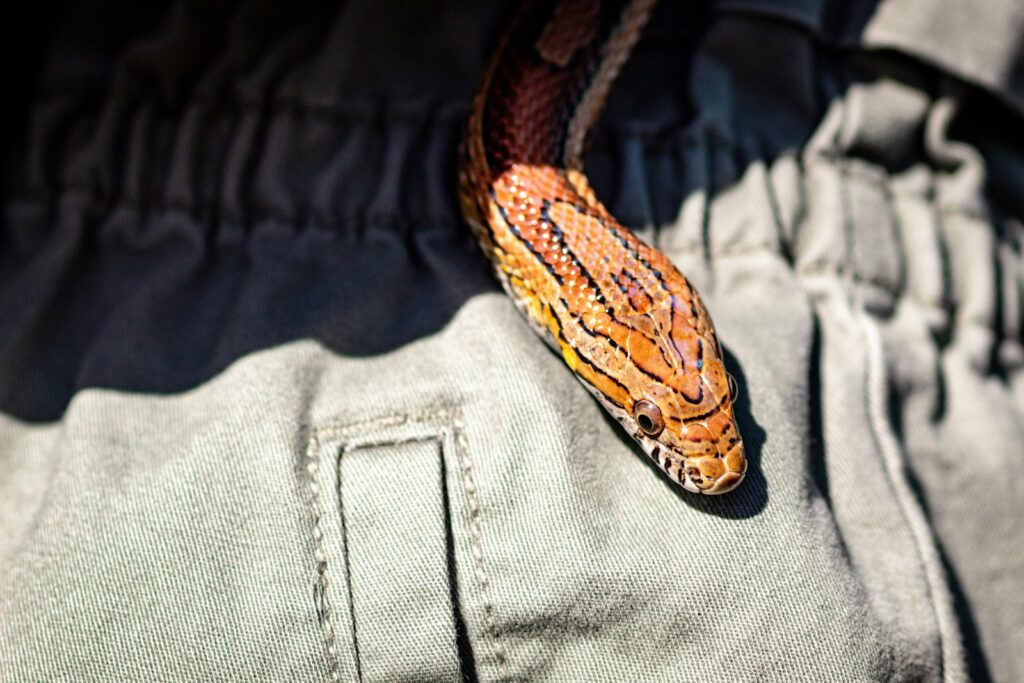
While striped patterns exist in various corn snake lines, the true Genetic Stripe represents a distinct recessive mutation that creates one of the most perfectly defined stripe patterns in any snake species. Unlike other pattern variations that might produce irregular or broken stripes, Genetic Stripe corn snakes display two crisp, continuous parallel lines running from neck to tail along a solid-colored background. The ventral surface of these snakes typically shows minimal patterning, enhancing the clean, streamlined appearance. What many enthusiasts don’t realize is that Genetic Stripe actually affects the formation of the pattern during embryonic development, essentially turning what would be horizontal saddle markings sideways into vertical alignment. When combined with vibrant color morphs like Caramel or Sunglow, Genetic Stripe corn snakes become ribbon-like living art pieces with their perfect linear definition and high-contrast edges.
Micropredator: The Miniature Marvel
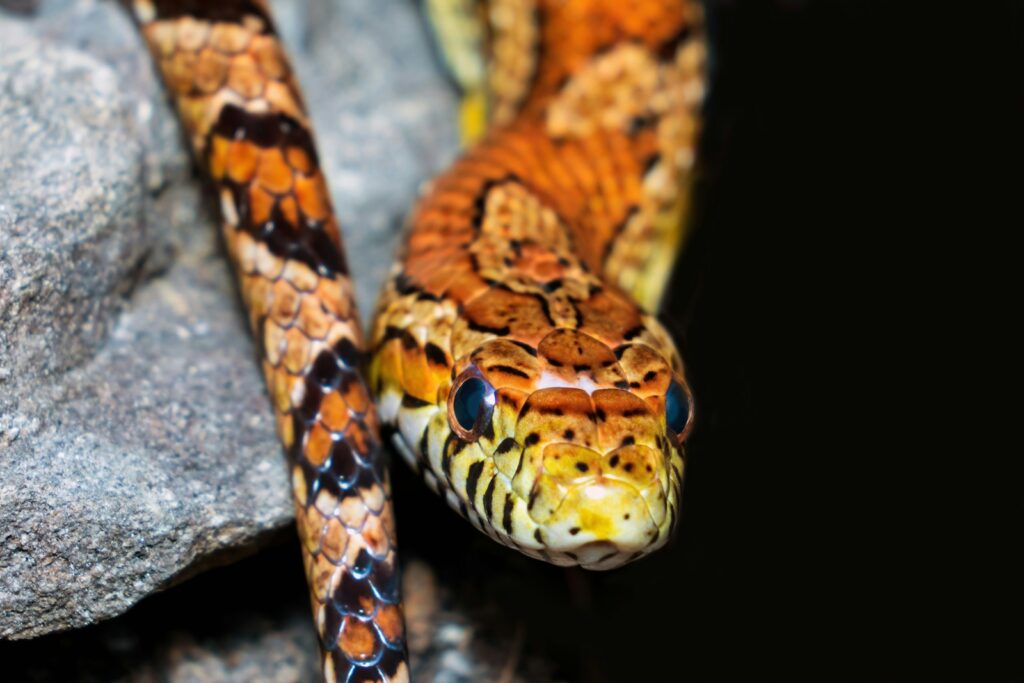
Micropredator corn snakes represent a fascinating line bred specifically for their diminutive size rather than color variations. Through selective breeding of the smallest specimens across generations, Micropredator breeders have developed corn snakes that typically reach only 2-3 feet in length at maturity, compared to the 4-5+ feet standard for the species. While not technically a color morph, Micropredators can display any color or pattern mutation, creating tiny versions of even the most complex morphs. Their reduced size makes them particularly appealing for keepers with space limitations or those who find smaller snakes more manageable. Despite their smaller stature, healthy Micropredator lines maintain normal proportions and robust health, distinguishing them from simply stunted specimens. The genetic mechanisms behind this size reduction aren’t fully understood but appear to involve multiple genes acting in concert rather than a single mutation, making this one of the few polygenetic traits commonly bred in corn snakes.
Cinder: The Ashen Beauty
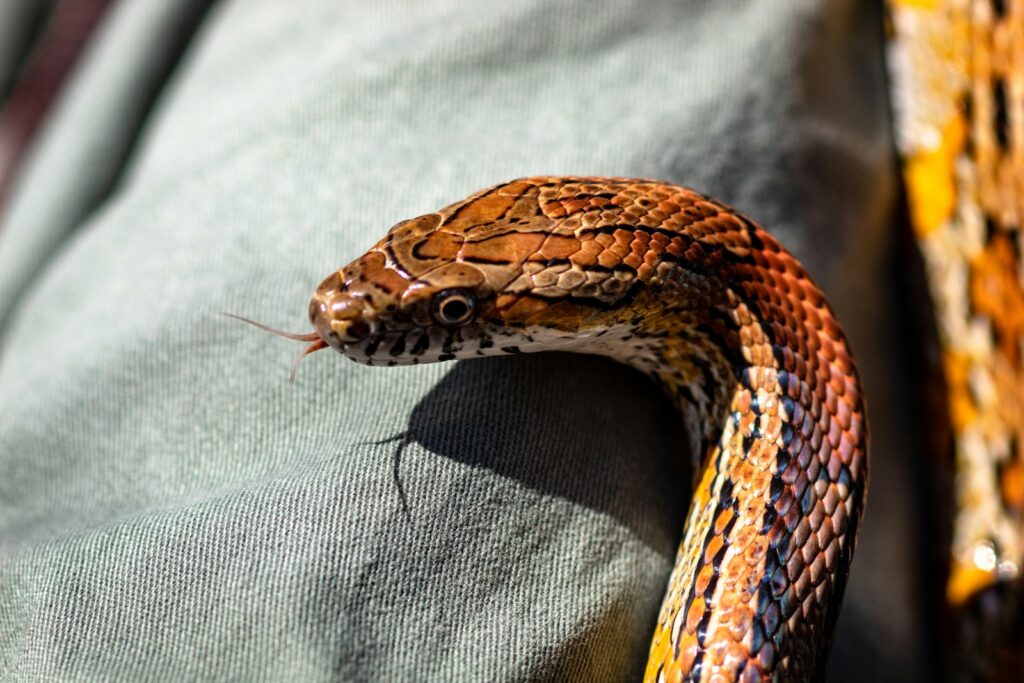
The Cinder morph creates corn snakes with a distinctive sooty or ashen appearance overlaying their base coloration. This unusual trait causes a smoky darkening that affects the snake’s entire body, creating a dramatic variation that works particularly well with orange and red-based morphs. Unlike simple melanistic specimens that appear uniformly dark, Cinder corn snakes retain their pattern definition while gaining an almost antiqued or vintage quality to their appearance. The genetic basis of the Cinder trait involves a co-dominant mutation that continues to be studied by specialist breeders interested in its unusual expression. Homozygous Cinders (those with two copies of the gene) display even more intense darkening, sometimes appearing almost charcoal in certain lighting conditions. These snakes have developed a dedicated following among enthusiasts who appreciate their mysterious, somewhat gothic aesthetic that sets them apart from the typically bright and vibrant corn snake palette.
Future Horizons: Emerging Genetic Frontiers
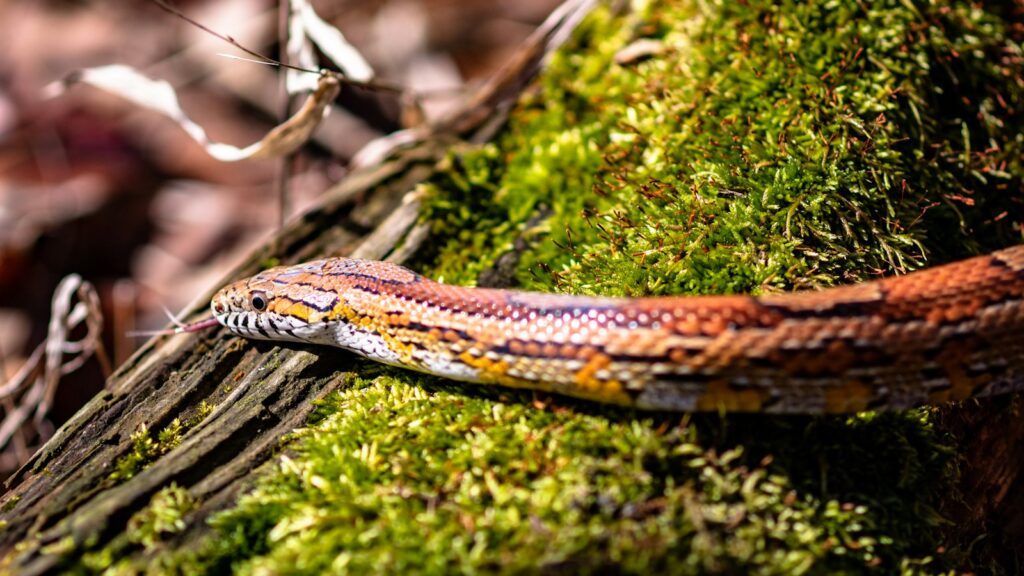
The world of corn snake morphs continues to evolve at a remarkable pace, with new variations emerging regularly through both unexpected mutations and deliberate genetic projects. Several breeders are currently working on developing true green corn snakes—a color that has proven particularly elusive in this species despite being common in other colubrids. Others are focusing on enhancing metallic iridescence, similar to what’s seen in certain python species, through selective breeding of specimens showing increased reflective properties in their scales. The application of advanced genetic techniques like CRISPR may eventually allow for even more dramatic modifications, though such approaches remain theoretical in reptile breeding for now. As our understanding of reptile genetics advances, it seems likely that corn snakes will continue to be at the forefront of color and pattern development, with their genetic plasticity and ease of breeding making them perfect candidates for exploring new morphological frontiers.
The remarkable diversity of corn snake morphs demonstrates not only the genetic flexibility of this species but also the creativity and dedication of the breeders who have developed these striking variations. From subtle color shifts to dramatic pattern alterations, each morph tells a story of genetic discovery and careful selective breeding. While popular morphs will always have their place in collections, these lesser-known varieties offer exciting possibilities for enthusiasts looking to explore the cutting edge of corn snake genetics. As breeding techniques continue to advance and new mutations emerge, we can only imagine what extraordinary corn snake morphs might appear in the decades to come, further cementing this species’ status as one of the most visually diverse reptiles in the world of herpetoculture.

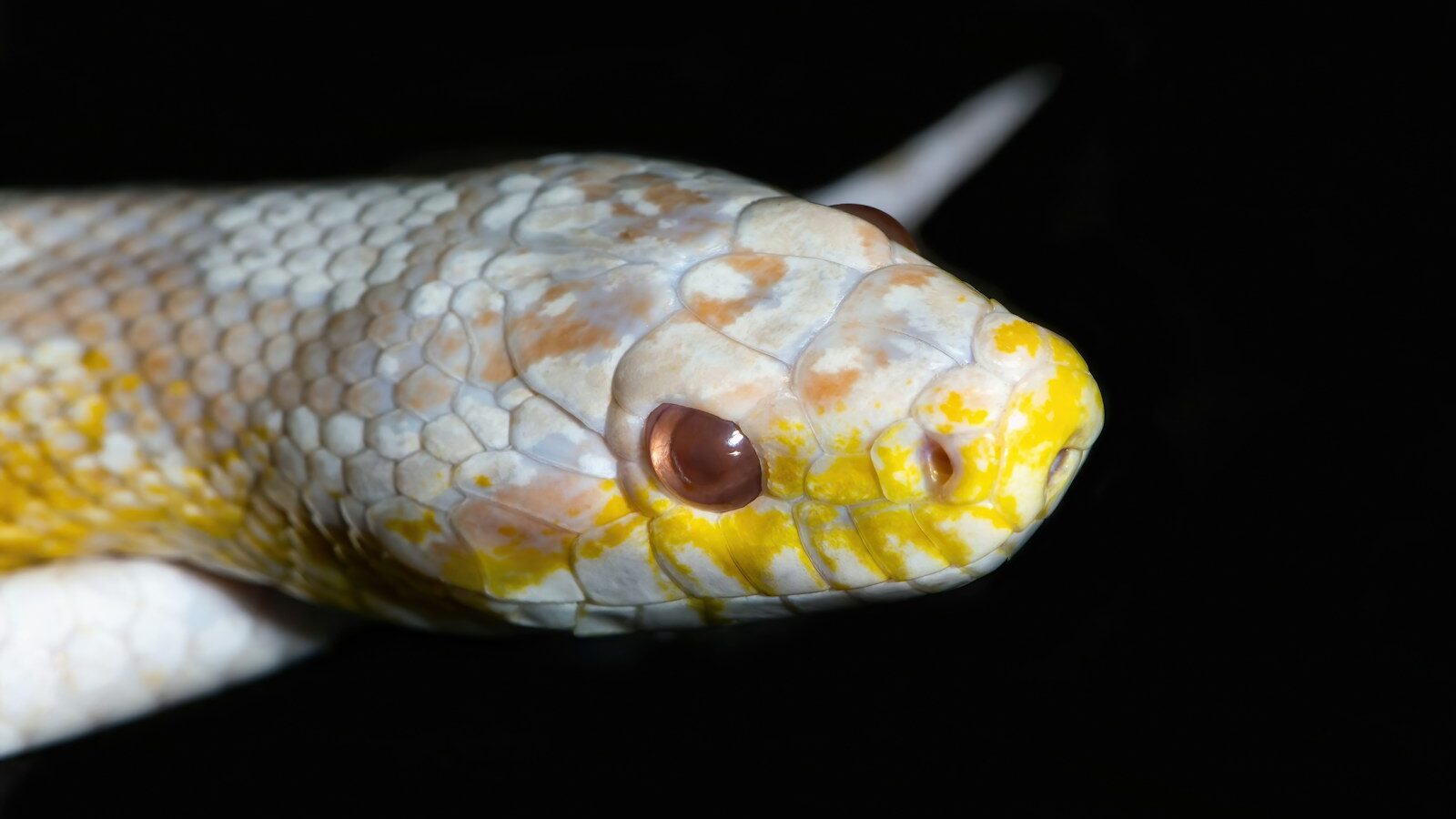
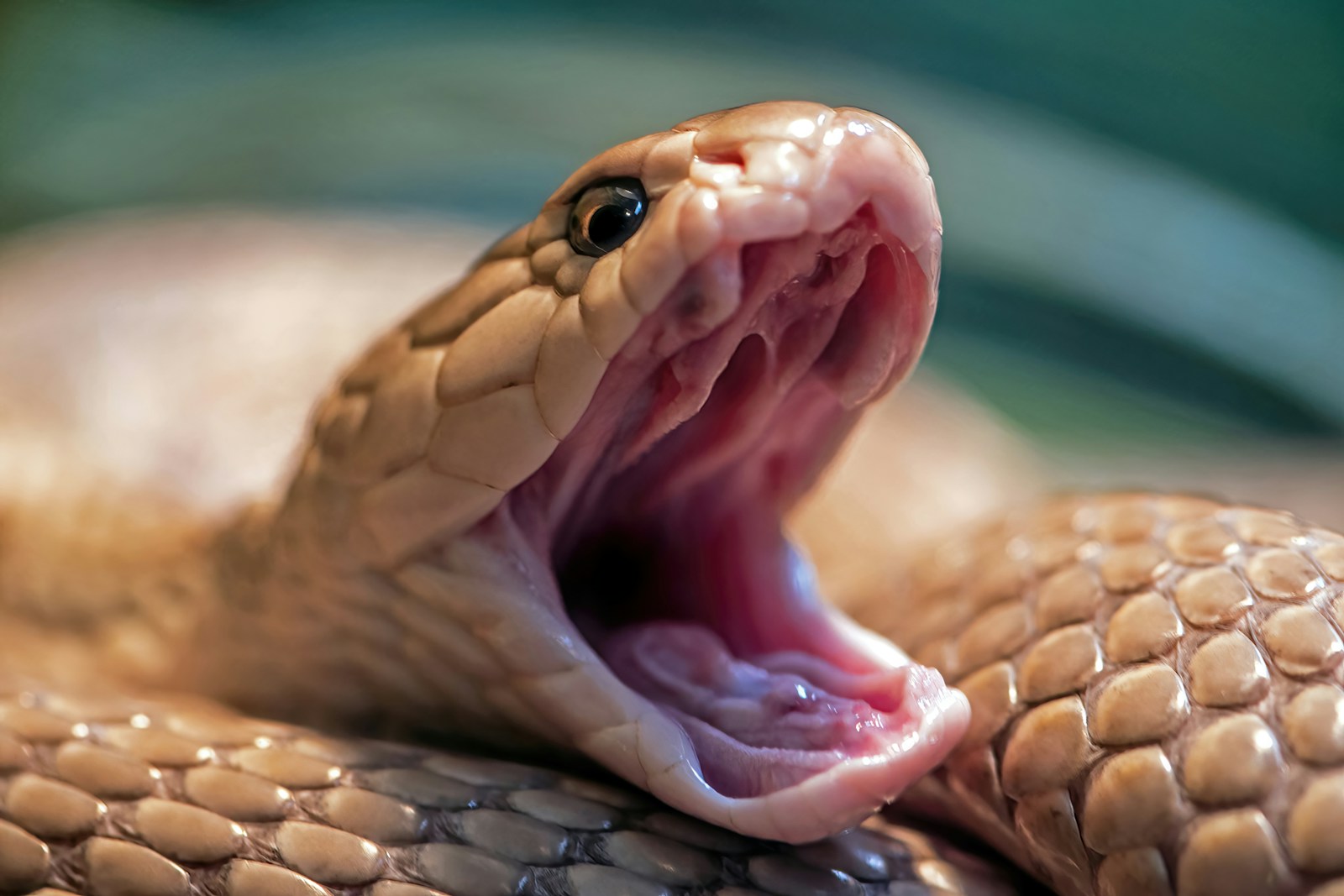



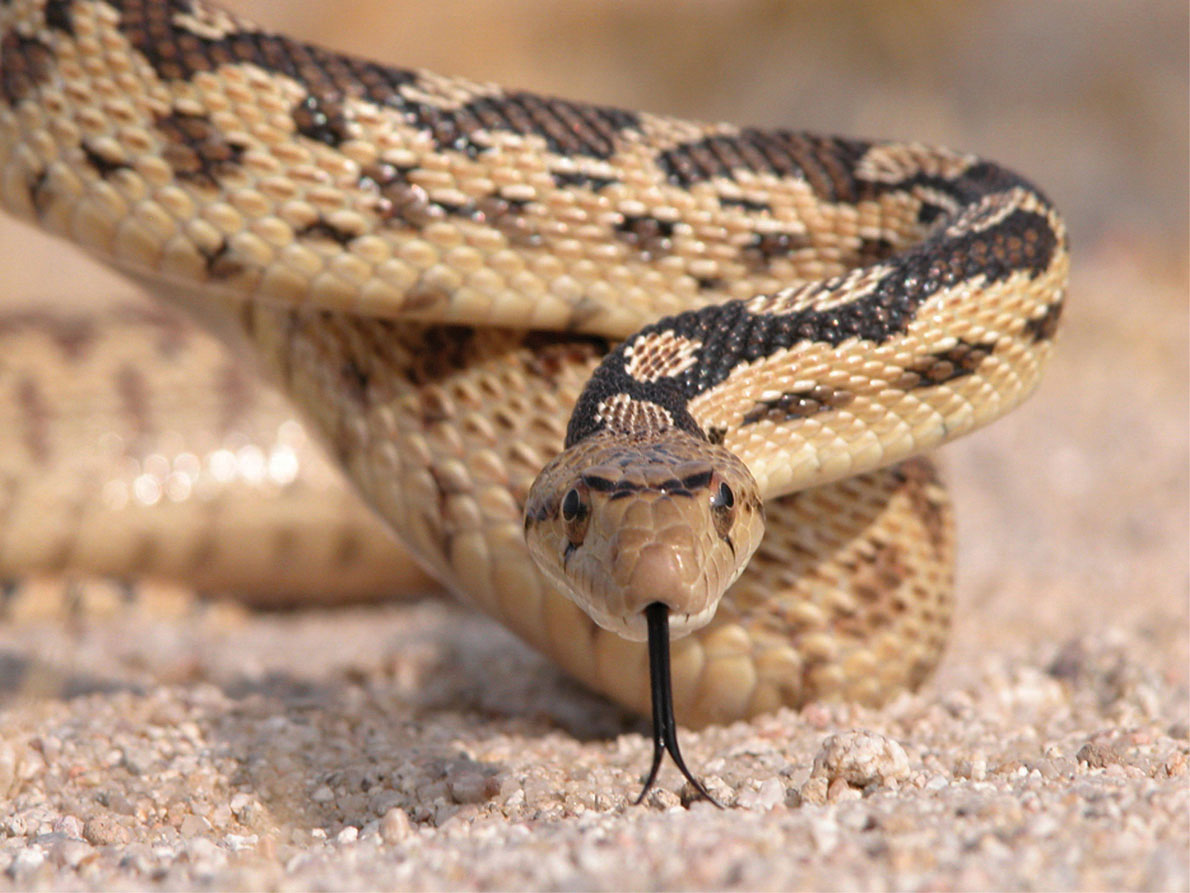


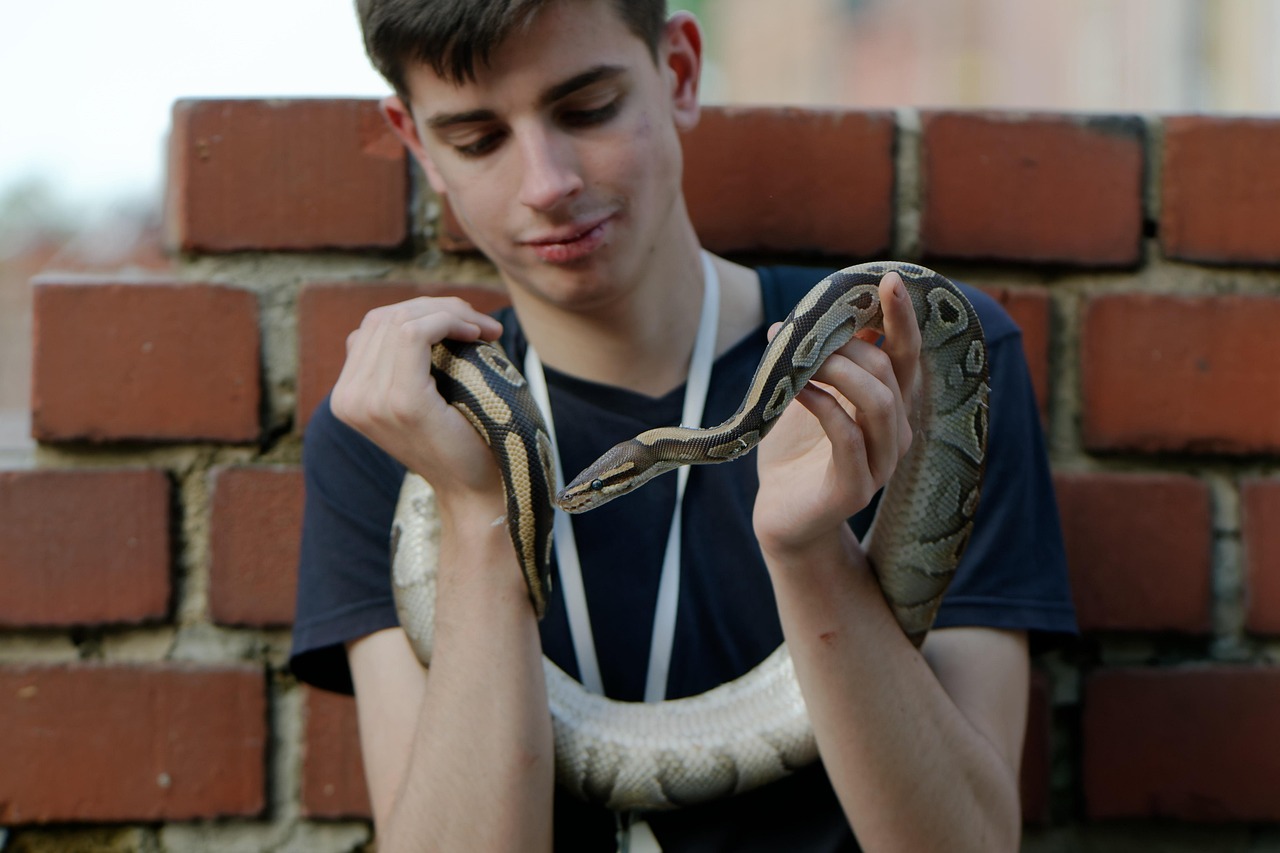
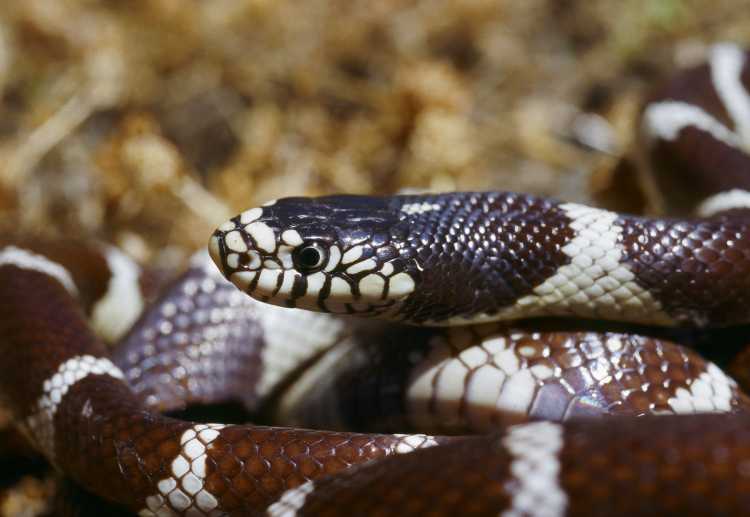
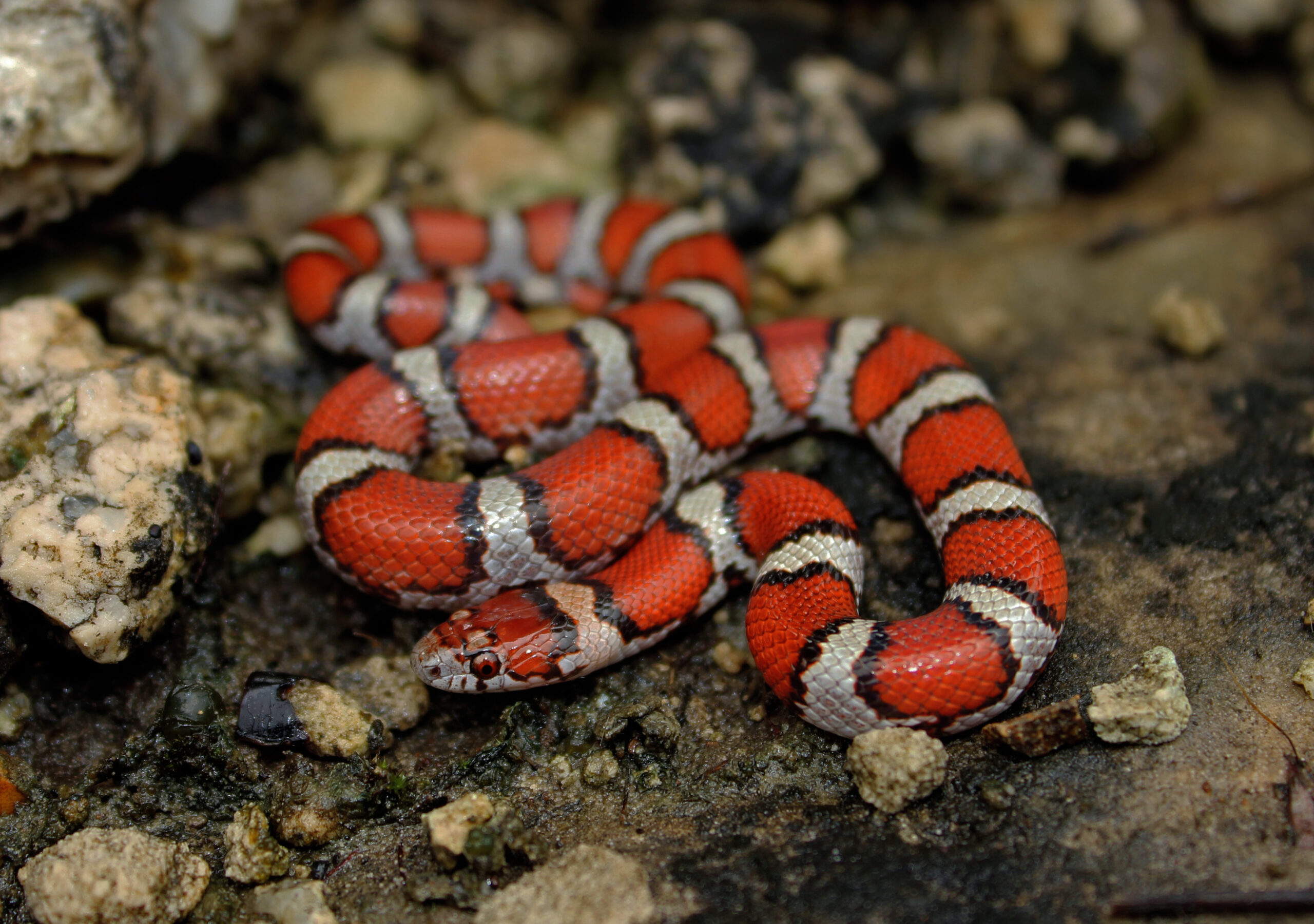




Leave a Reply